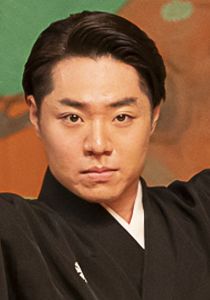
Nakamura Takanosuke: Kabuki Heir Soaring to New Heights
People Culture History Arts- English
- 日本語
- 简体字
- 繁體字
- Français
- Español
- العربية
- Русский
Son of a Kabuki Legend
Kabuki is a centuries-old form of popular theater whose art has been passed down through the generations from father to child, from master to apprentice. Nakamura Takanosuke is the son of Nakamura Tomijūrō V (1929–2011)—an actor renowned for his sharp delivery and highly expressive dancing style who was designated a living national treasure in 1994. Takanosuke was born in 1999, when Tomijūrō was already 69 years old.
“I never received detailed instruction from my father while I was young,” Takanosuke recalls. “I had a few dance lessons, but my father never forced me to learn, telling me, ‘I’ll teach you properly when you turn fourteen.’ He encouraged children to see kabuki as a form of play, to have fun with it and develop a fondness for it. This is something he learned from reading Zeami’s Fūshi kaden”—the early-fifteenth-century treatise by the founder of the nō theater offering practical guidance for his successors.
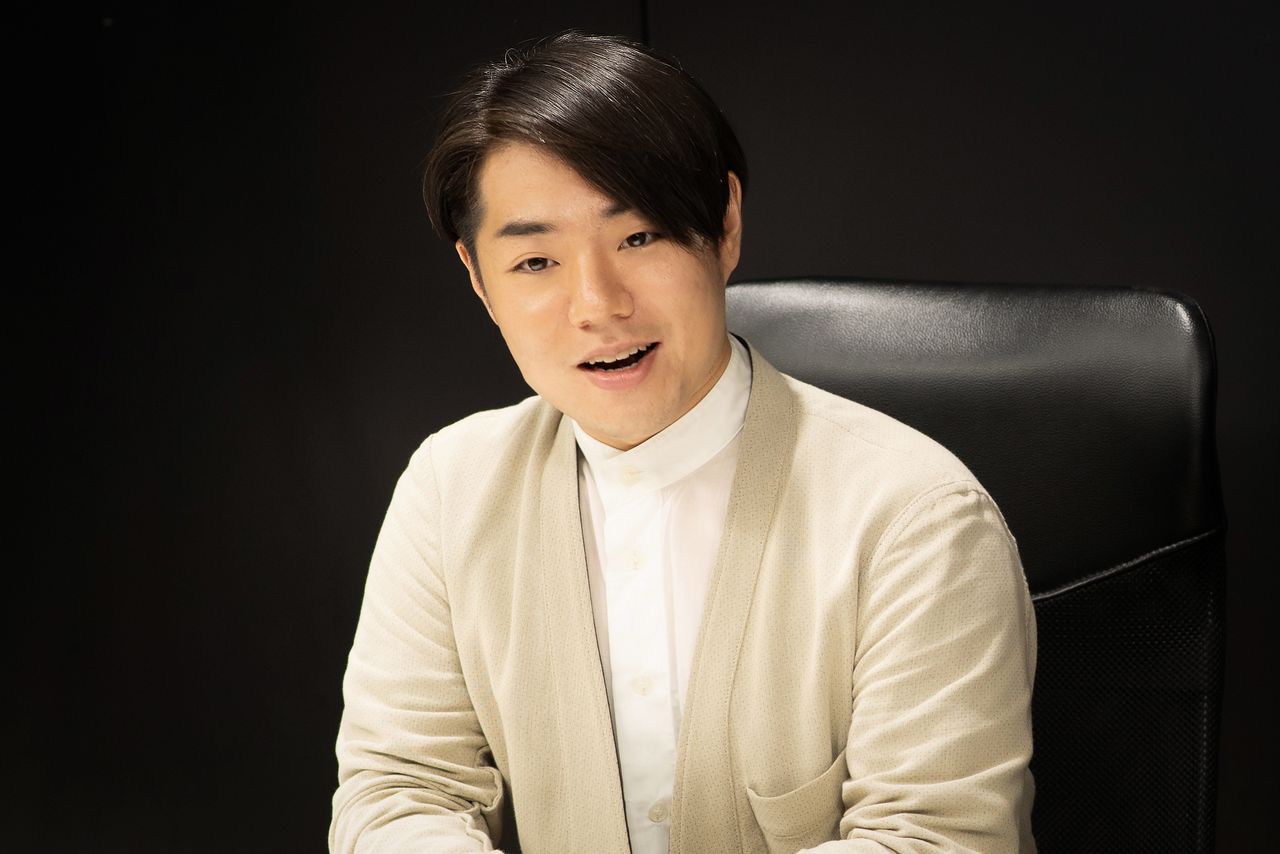
Nakamura Takanosuke. (© Matsuda Tadao; courtesy of Office Takaya)
Many top kabuki actors are known by illustrious stage names (myōseki) and family titles (yagō), which are, as a rule, passed down from father to son and grandson. Actors will take on new names as they progress in their careers before being bestowed the most coveted names. Along with the myōseki, actors also inherit the acclaimed plays and roles of their previous namesake.
Takanosuke is a name given by his father that he first used onstage when the actor was six years old. He played the role of Ushiwakamaru—the boyhood name of Genji general Minamoto no Yoshitsune—in a performance at the Kabukiza theater. “Our family’s yagō is Tennōjiya; this comes from the temple Shitennōji in Osaka, which has a legend related to hawks. And our family crest is the takanoha yatsuya-guruma”—a wheel of eight hawk-feathered-arrows—“so my father came up with the idea of using taka, or hawk, in my name.”
Tomijūrō’s next plans were to entrust his own myōseki to Takanosuke when his son turned 20—and he himself became 90—and to have the new Tomijūrō perform Kyōganoko musume Dōjōji, the prized heirloom dance of the Tennōjiya family, as a milestone event. The elder Nakamura passed away, however, at the age of 81 in 2011.
“I was just eleven years old when my father died and had no idea of the training he had in mind for me. For a kabuki actor, one’s father is usually the most important teacher. Having lost my teacher so early, I wasn’t sure whether I’d be able to survive in this world. There were admittedly some very trying times, but I never once thought of quitting.”
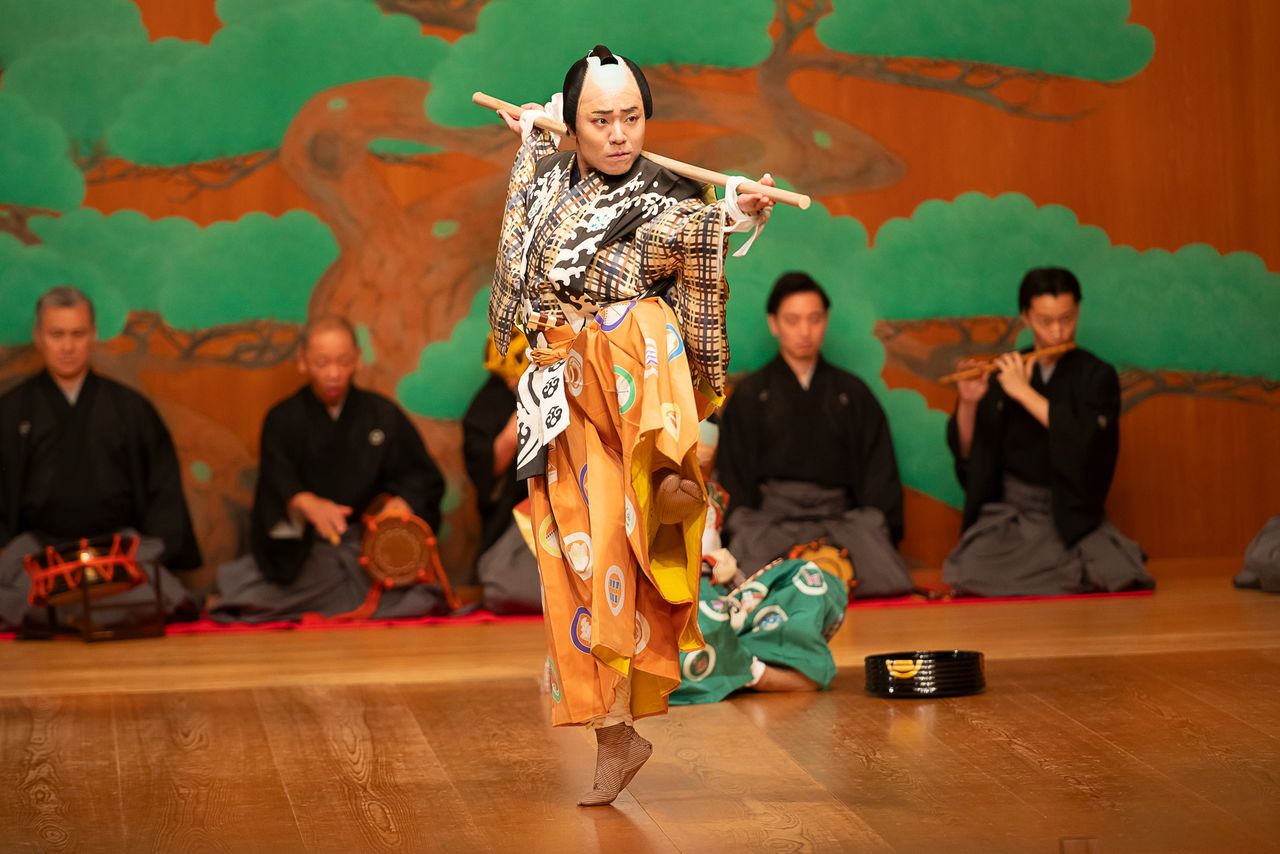
Takanosuke performs in the ninth Shōnokai in 2024. (© Matsuda Tadao; courtesy of Office Takaya)
Better Than a Hundred Days of Practice
In 2013, to mark the third anniversary of his father’s death, Takanosuke—then 14—launched a series of annual, privately organized recitals called Shōnokai. This year’s performance was the ninth held to date, having been suspended for a few years during the pandemic.
“The recitals are learning opportunities, allowing me to perform the plays that I happen to be interested in at the time. This will hopefully prepare me for roles that may someday come my way in commercial productions at major theaters. There’s a saying that goes, ‘A single performance is worth more than a hundred days of practice.’ Practice is important, of course, but the experience gained from performing before a live audience is invaluable, and Shōnokai is a vehicle to acquire such experience. The program features plays that either are closely associated with my father or are classics of the Edo kabuki repertoire.”
In 2022, at the seventh Shōnokai, Takanosuke performed the lead role in Funa Benkei, a kabuki dance adapted from the nō play of the same name and based on the epic chronicle Tale of the Heike. In 2023, he performed the same piece—one of his father’s favorite plays—at the Kabukiza, prompting rave reviews. Writing in the Tokyo Shimbun in February 2023, kabuki historian Yanai Kenji commented on the beauty of his footwork. There is energy permeating every corner of his body, the writer noted, adding that he looked forward to seeing Takanosuke’s art mature in the future.
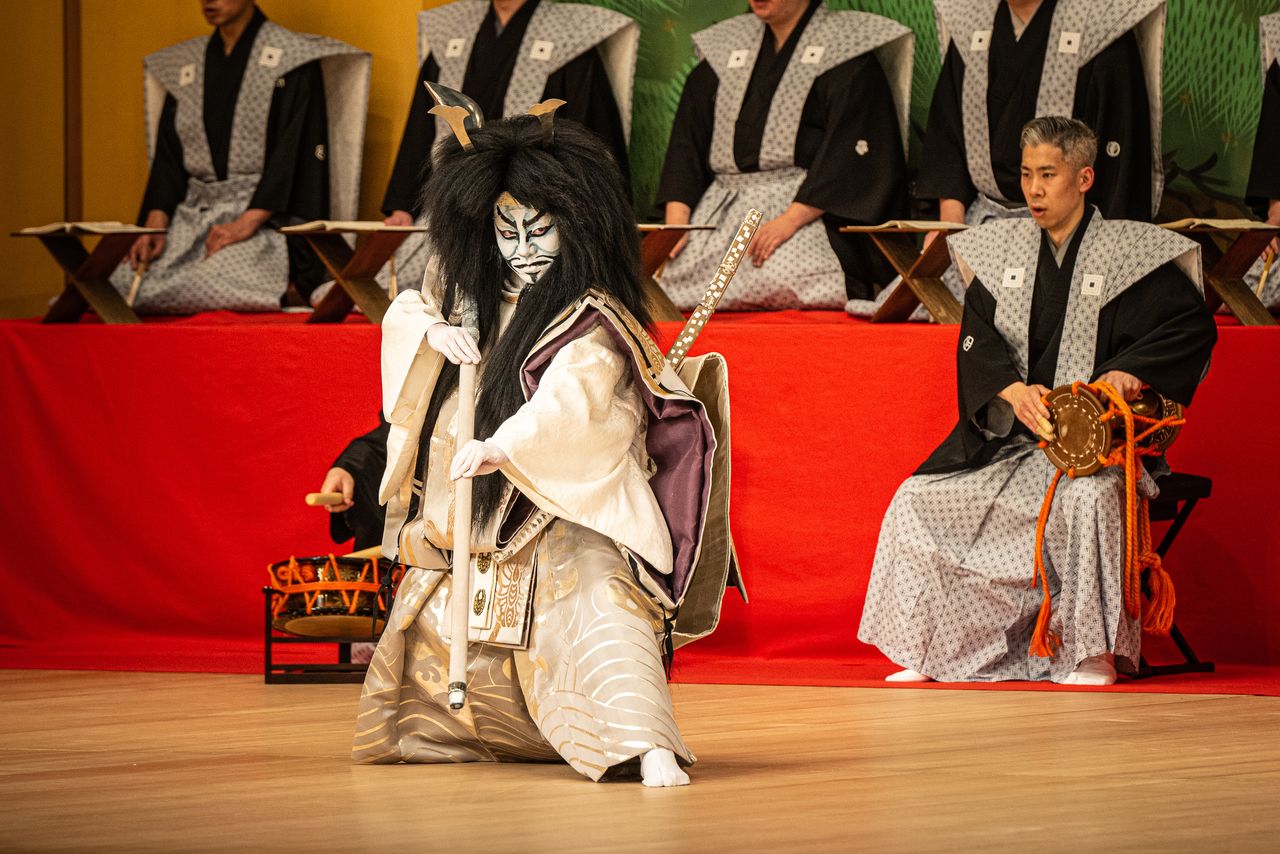
Takanosuke in 2022 takes on the Funa Benkei role his father had loved to play. (© Matsuda Tadao; courtesy of Office Takaya)
Takanosuke has recently come to recognize the many seeds for artistic development that had been sown by his father.
At his father’s urging, for example, as early as first grade Takanosuke began learning shimai (short nō dances) from Katayama Yūsetsu, a renowned Kanze-school nō actor who was a living national treasure. “My father also studied nō when he was young and spent a great deal of time practicing the distinctive suriashi style of walking. But as a child, I didn’t enjoy the nō lessons and often wondered why I had to do this.”
But now he is deeply grateful for having been exposed to nō so early in life and is currently continuing his studies under Yūsetsu’s eldest son, Katayama Kurōemon X. “Footwork is very important in kabuki dance as well, and through nō I learned how to ground my body. Many kabuki plays are adaptations of much older works from the nō and kyōgen repertoire, and by learning the original plays, I gained a deeper appreciation of the qualities that make kabuki interesting and how they can be more convincingly presented. That, I believe, was what my father intended for me to learn through the nō lessons.”
Collaboration with Other Traditional Arts
The ninth Shōnokai held in August this year at the National Noh Theater in Tokyo featured a special guest from outside the kabuki world: Nomura Yūki, a young star of kyōgen—the comic theatrical form that developed in tandem with nō—with whom Takanosuke performed a dance called Ninin sanbasō. Both born in 1999, the two actors met through Kurōemon and soon became friends. They share the fact that they hail from illustrious acting families and are keen on taking on new challenges while upholding the best of their respective traditional performing arts.
The dance they performed was originally part of a ritual-like nō play in which the kyōgen comic actor moves energetically about the stage to pray for a bountiful harvest. It was later incorporated into the kabuki repertoire and is performed on special, ceremonious occasions, such as the opening kaomise (“face-showing”) productions of the kabuki calendar year and shūmei (“name-taking”) performances. While the musical accompaniment in the kabuki version is centered on the shamisen, for this performance, the original nō orchestration was used. Dressed in black kimonos and hakama trousers, rather than costumes, Takanosuke and Yūki respectively performed the kabuki and kyōgen dances, enabling the audience to enjoy the contrast between them.
“Dance began as a form of prayer to the gods. This is something I perceived firsthand while I was performing Sanbasō with Yūki. Sanbasō holds a prestigious place and is imbued with an element of ritual, but in kabuki these qualities are enhanced through the use of makeup and stage props. The nō rendition, though, doesn’t rely on such props. It’s thus less adorned and feels more consecrated and electrifying. In nō, the actor rouses the earth through his dance and taps into its energy. The use of the body is also completely different from kabuki. Understanding this difference gave me new insights into kabuki’s role as a form of popular theater and how it can be staged more effectively.”
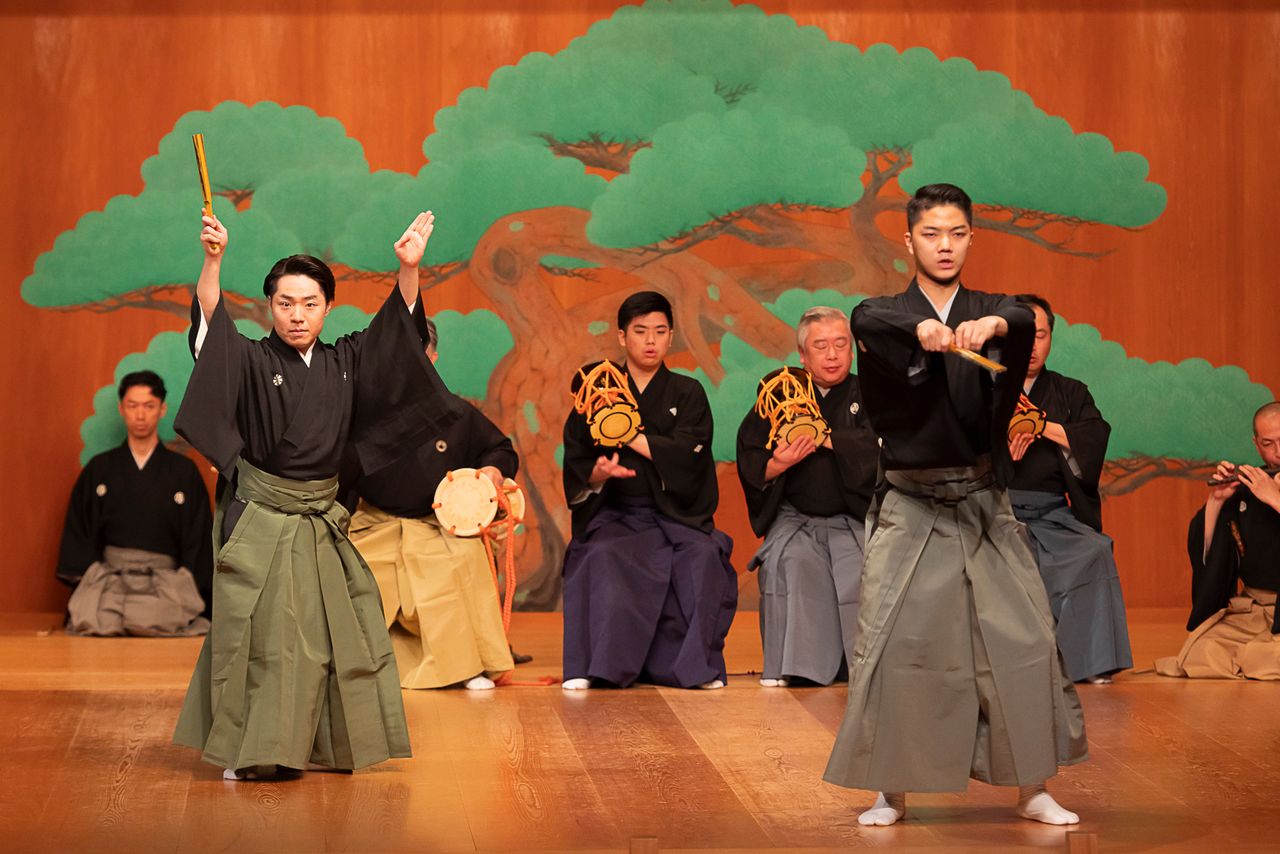
Nomura Yūki, at right, performed with Takanosuke to display the connections between nō/kyōgen and kabuki, as well as their differences. (© Matsuda Tadao; courtesy of Office Takaya)
Also at Shōnokai, Takanosuke paired with kabuki actor Onoe Sakon, seven years his junior, to perform Bōshibari—another adaptation from a kyōgen play. Takanosuke played Jirōkaja, a servant who has a habit of sneaking into his master’s warehouse and helping himself to the sake stored there. Thus, the master, before he leaves the house on an errand, ties Jirōkaja’s arms to a pole and the arms of his other servant, Tarōkaja, behind his back. Although the two are unable to reach the coveted drink on their own, they work out a clever way to take turns enjoying the beverage. The master returns home to find his two servants tipsy and dancing. The play is thoroughly entertaining but also requires considerable skill to perform convincingly.
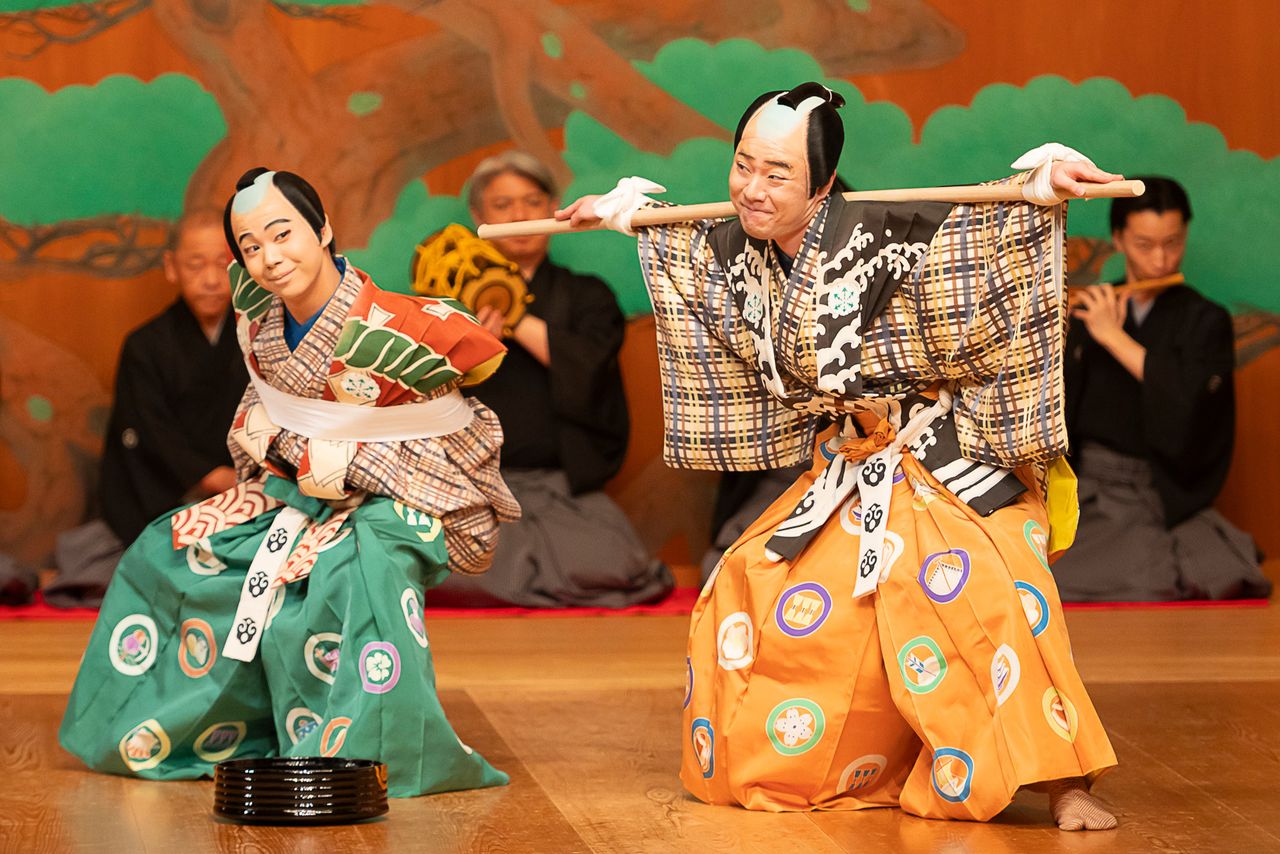
Takanosuke, at right, and Sakon, at left, were instructed by Sakon’s father Onoe Shōroku IV in ways to approach their Bōshibari roles. (© Matsuda Tadao; courtesy of Office Takaya)
Modern-Day Plays as a Gateway to the Classics
Last year, Takanosuke appeared in a series of widely talked about shinsaku (contemporary) kabuki productions, including Tōken ranbu, Mahābārata senki (The War Chronicles of the Mahabharata), and Lupin III.
“These new plays have a contemporary feel because they’re adaptations of modern or nontraditional works. But they’re staged using the conventions of classical kabuki, and I was struck by how important it was to achieve mastery of those conventions. A full command of the fundamentals is indispensable when improvising. That’s why I hope to immerse myself in the classics while I’m still young and to master the theatrical techniques that are unique to kabuki.”
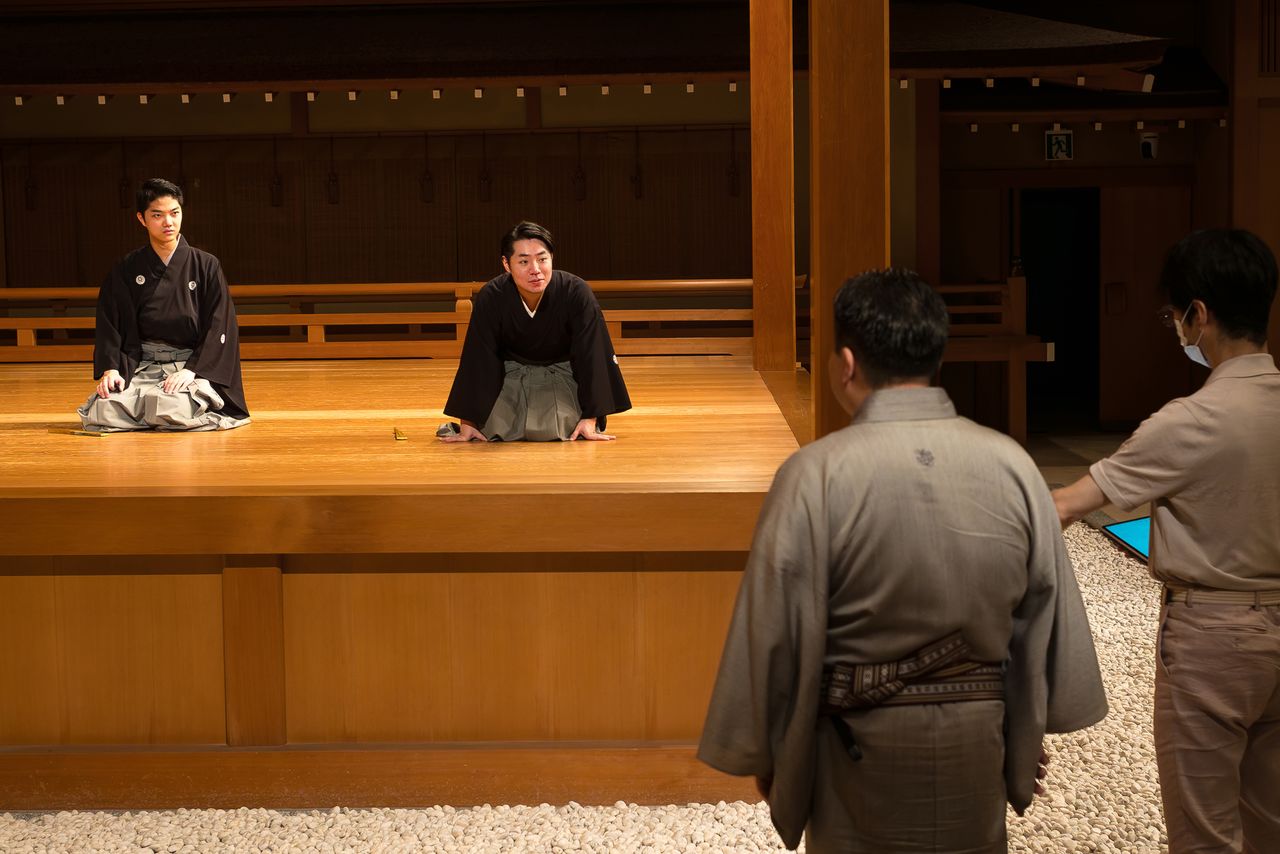
Takanosuke and Nomura Yūki rehearsing for Ninin sanbasō. At right, offering instruction, are Yūki’s father Nomura Mansai II and the celebrated choreographer Fujima Kanjūrō VIII. (© Matsuda Tadao; courtesy of Office Takaya)
Tōken ranbu, in particular, was a mold-breaking production, having originally been an online game that later spawned a popular series of anime films and a musical. The story revolves around “sword warriors”—personifications of legendary swords—who battle evil forces known as “historical revisionists” to preserve the timeline. Takanosuke gained a new, younger following by being doubly cast as one of the main sword warriors, Dōdanuki Masakuni, and the samurai Matsunaga Hisanao.
“Over half of the audience were Tōken ranbu fans who weren’t familiar with the classical conventions of kabuki, so I wasn’t sure how our production would go over with them. But the audience’s reaction was great from the opening day; people were really engrossed in what was happening on stage. The production prompted many people to come see traditional kabuki performances as well. And we had a much larger number of younger visitors at this year’s Shōnokai.”
Takanosuke views shinsaku kabuki as a vehicle to attract more people to the classics. “If the first play younger people were to view was Kanadehon chūshingura, a tale of loyalty and revenge inspired by an eighteenth-century act of vengeance by the famed ‘47 loyal retainers,’ they probably wouldn’t be able to relate to it. That’s because our values and sensibilities have completely changed today. The new kabuki plays would be a better introduction, and viewers can proceed to the classics if they’re interested.”
Even if the story or the lines are hard to follow at first, “There’s still a lot to enjoy—the music, for instance, or the costumes, set design, and scene changes. You might also become a fan of a particular actor. If you develop an interest in any aspect of kabuki, your appreciation is bound to deepen from there. This is a performing art that’s been around for over four hundred years. I’m sure that exposure to a live performance will stir something in viewers of all ages.”
Experimenting with the Classics
Upholding the classics, Takanosuke believes, does not mean rejecting change. “Kabuki is a living art form. It has gone through many major changes since the Edo period. Our biggest challenge as practitioners is to present shows that will captivate younger audiences today and the generations to follow.”
His father, Tomijūrō, was a key figure in an experimental movement led by theater director and critic Takechi Tetsuji (1912–88). “Takechi Kabuki” was an attempt to revive the classics through modern interpretations. “Becoming involved in a similarly groundbreaking endeavor would be a great learning experience. And I’m also eager to absorb new ideas through my engagement with shinsaku kabuki and collaboration with artists from different genres, like nō and kyōgen.”
Asked about his long-term goals, he answers without hesitation: “To become fully versed in the classics and succeed to my father’s stage name. Before becoming Tomijūrō VI, though, I need to have a clear idea of the kind of kabuki I aspire to. To that end, I’m broadening my horizons while I’m still young by trying a lot of different things.”
In November, he will be starring in his first Western-style play, Uchōten kazoku (The Eccentric Family), a story about a tanuki family who disguise themselves as humans and live in Kyoto. His kabuki schedule is busy as well, as he will be appearing at the kaomise performance in December at the Minamiza Theater in Kyoto and in January at the New Year Asakusa Kabuki—considered a “gateway to success” for up-and-coming actors—at which he will be co-starring with other leading figures of his generations, including Onoe Sakon, Nakamura Hashinosuke, and Ichikawa Somegorō.
Takanosuke is already possessed of excellent stage posture cultivated through the study of shimai dances and a clear, ringing voice. His sharp delivery of lines and exceptional dancing skills are also great assets. And he will no doubt soar to even greater heights with experience in lead roles at kabuki’s biggest commercial productions.
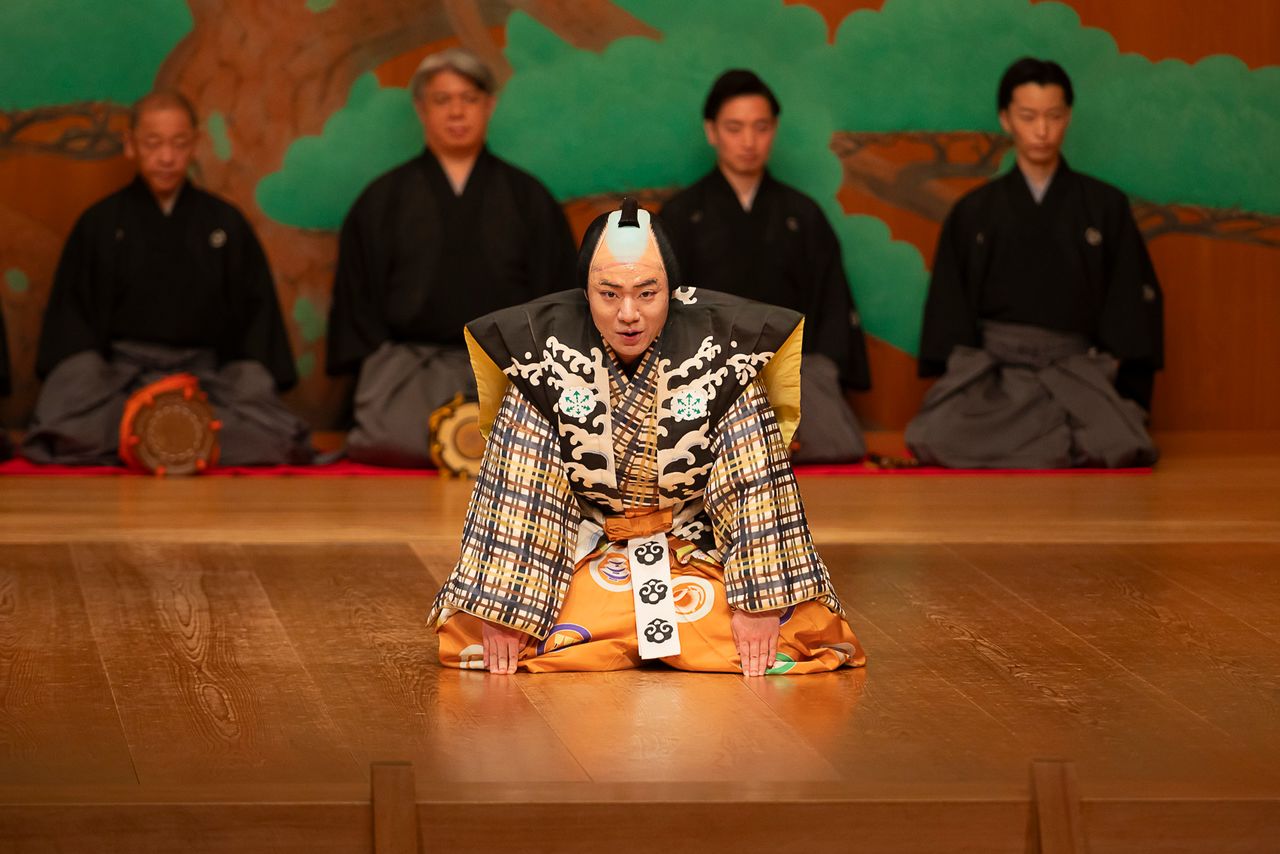
Takanosuke closed the 2024 Shōnokai performance with a pledge to strive for still greater things in his art. (© Matsuda Tadao; courtesy of Office Takaya)
(Originally written by Kimie Itakura of Nippon.com and published in Japanese on October 3, 2024. Banner photo © Matsuda Tadao; courtesy of Office Takaya.)

